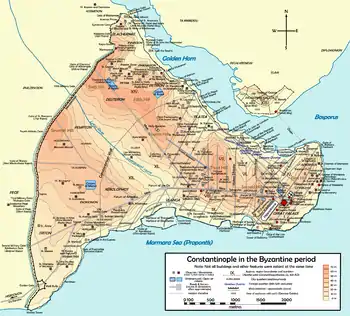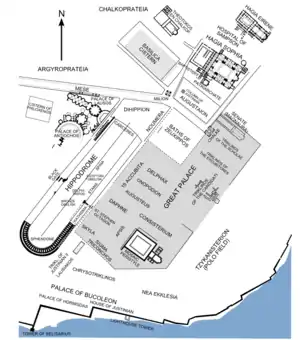Baths of Zeuxippus
The Baths of Zeuxippus were popular public baths in the city of Constantinople, the capital of the Byzantine Empire. They were built between 100 to 200, destroyed by the Nika revolt of 532 and then rebuilt several years later.[1] They were so called because they were built upon the site where a Temple of Zeus (Jupiter) had formerly existed.[2] They were built around 500 yards south of the much older baths of Achilles of the earlier Greek Acropolis in Byzantion. The baths were famed primarily for the many statues that were built within, and the famous people they each represented. However, they were later used for military purposes, during the seventh century. Excavations of the site and the Baths were made in 1928.

Description
The original baths, which were founded and built by Septimius Severus,[3] and decorated under Constantine I[4] were adorned with numerous mosaics and over eighty statues,[1] mostly those of historical figures, with Homer, Hesiod, Plato, Aristotle, Julius Caesar, Demosthenes, Aeschines and Virgil all among them,[3] as well as the figures of gods and mythological heroes;.[5] These statues were taken from various places worldwide, including regions such as Asia and the surrounding areas, Rome, Greece and Asia Minor.[6] The Baths did, indeed, follow a trend of architecture during the period; places such as the Palace of the Senate, that of the Forums, the Palace of Lausus were all adorned with similar statues, of heroes (mythological and not), historical figures, and powerful people, becoming part of a contemporary form of artful architecture.[7]
For a relatively small fee, entrance could be gained by any member of the general public to the Bath complex. While the area was obviously primarily used for public bathing, one could exercise and enjoy a variety of recreational activities. Attendants were paid to oversee these activities, and the happenings of the complex, enforcing opening and closing times, and the rules of conduct. Men and women were not allowed to bathe together; they would either be in separate baths, or bathe at different times of the day.[8]
The popularity of the Baths of Zeuxippus was very great among the citizens, despite the numerous baths that had been available for public access at the time in Constantinople,[9] and therefore the great competition that existed in that commercial area. Even the likes of clergy and monks were seen there, despite the insistence by their superiors that the baths were places of impious behaviour.[8]
Location

The 12th century scholar Zonaras tells of how Severus connected the baths to the Hippodrome and, in doing so, built it on the site of the Temple of Jupiter. However, Leontius, who was more accurate in his writings (which also predate those of Zonaras), instead asserted that the baths were not actually joined to the Hippodrome, but was simply close to it:
Between Zeuxippus' cool refreshing baths,
And the famed Hippodrome's swift course I stand.
Let the spectator, where he bathes himself
Or sees the struggling steed panting for breath
Pay a kind visit, to enhance his pleasures;
He'll find a hearty welcome at my table.
Or if more manly sports his mind affects,Practice the rough diversions of the stadia.[2]
In addition to this, the Baths of Zeuxippus were also close (most probably adjacent) to the Great Palace grounds.[10] This evidences their popularity, as such a location would have attracted many people, being in such great proximity to such significant places. The square of the Augustaeum and the basilica of Hagia Sophia were also close to the Baths.
The map to the right shows the Baths' approximate location within Constantinople, as determined by excavations made there. As can be seen, the Baths were roughly quadrangular in shape, and were, indeed, very close to, or even "connected" to the Palace, as Zonaras indicated.
Destruction and later use
As a result of the Nika revolt of 532, which constituted the worst uprising Constantinople had seen at the time, and which left half of the city in ruins and thousands of people dead, the original Baths of Zeuxippus were destroyed in blazing fire.[1] While Justinian took action to rebuild the Baths, he could not recreate or restore the statues or the antiquities that were lost in 532.[3]
Soon after this however, in the early 7th century, as a result of extreme military and political pressure on the Byzantine Empire, public bathing changed from being a common luxury to a rare and infrequent one, and many public facilities and venues began to be used for the austere purposes of the military.[8][11] They are last attested as being used as baths in 713, before being converted to other uses: part of the building became the prison known as Noumera, while another part appears to have been used as a silk workshop.[12]
Almost 1,000 years later, in 1556, the Ottoman architect Mimar Sinan built the Haseki Hürrem Sultan Hamamı on the same grounds. Later still, in 1927-1928, excavations were made at the site, and many historical relics were recovered, such as earthenware and glazed pottery, giving unique insights into the architectural designs and social interests of the people and culture of Constantinople at the time.[12][13]
Most particular of the objects found at the site were two statues which were inscribed with the words Hekabe and Aeschenes [sic] on their bases, giving rise to the theory that tells of how Christodorus of Coptus effectively wrote the six epigrams on the many statues of the Baths, and lending further plausibility to the writings of both Zonaras and Leontius.[14]
Inspired literature
Christodorus of Coptus, an Egyptian poet and writer wrote a lengthy (416 lines long) hexameter piece of poetry inspired by the glory of the statues housed within the halls of the Baths of Zeuxippus.[15] This poem actually consisted of a number of short epigrams (six in total), each focusing on one or a small group of statues within the Baths, designed to combine to form one work. While it has been suggested that the epigrams of Christodorus of Coptus may actually have been inscribed on the (bases) of the statues themselves, this is unlikely because of his use of the ekphrastic medium, and the presence of the past tense in the text.[14]
References
- Ward-Perkins, B. p. 935
- Gilles, P. p. 70
- Bury, J.B. p. 55
- Wornum, R.N.
- Müller, K.O.; Welcker, F.G. p. 208
- Evans, J.A.S. p. 30
- Gregorovius, F.; Hamilton, A. p. 80
- Rautman, M.L. p. 77
- Matthews, W. p. 230
- Tafur, P. p. 225
- Gibbon, E. p. 950
- Kazhdan (1991), p. 2226
- Zeuxippus Ware
- Johnson, S.F. p. 170
- Bowersock, G.W.; Grabar, O. p. 6
Sources
- Bryan Ward-Perkins The Cambridge Ancient History: Empire and Successors, A.D. 425-600. Cambridge University Press, 2000.
- John Bagnell Bury A History of the Later Roman Empire from Arcadius to Irene (395 A.D. -800 A.D.) Adamant Media Corporation, 2005. ISBN 1-4021-8369-0
- Pierre Gilles The Antiquities of Constantinople. Italica Press, Incorporated, 1998. ISBN 0-934977-01-1
- Kazhdan, Alexander, ed. (1991), Oxford Dictionary of Byzantium, Oxford University Press, ISBN 978-0-19-504652-6
- Marcus Louis Rautman Daily Life in the Byzantine Empire. Greenwood Press, 2006. ISBN 0-313-32437-9
- Edward Gibbon The History of the Decline and Fall of the Roman Empire. Penguin Classics, 1995. ISBN 0-14-043394-5
- Ralph Nickolson Wornum The epochs of painting characterized, a sketch of the history of painting, ancient and modern. 1847.
- Pero Tafur Travels and Adventures 1435-1439 Routledge, 2004.
- Scott Fitzgerald Johnson Greek Literature in Late Antiquity: Dynamism Didacticism Classicism Ashgate Publishing, Ltd., 2006. ISBN 0-7546-5683-7
- Karl Otfried Müller, Friedrich Gottlieb Welcker Ancient Art and Its Remains: Or, A Manual of the Archaeology of Art. 1852.
- J. A. S. Evans The Age of Justinian. ISBN 0-415-02209-6
- Ferdinand Gregorovius, Annie Hamilton History of the City of Rome in the Middle Ages
- William Matthews An historical and scientific description of the mode of supplying London with water. 1841